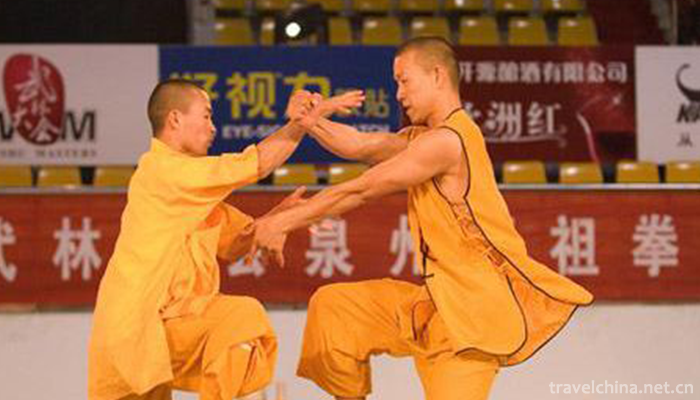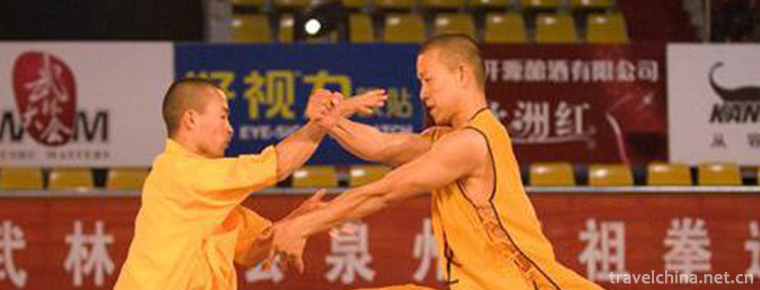Wuzuquan
Wuzuquan
Wuzu Quan is one of the Nanquan in traditional Chinese boxing. It is said that Cai Yuming (from Quanzhou, Fujian Province, 1853-1910) synthesized Baihe Quan, Monkey Quan, Arhat Quan, Dazun Quan and Taizu Quan, so it is called Wuzu Quan. Five-ancestor boxing is characterized by short fighting, tight door, and vigorous boxing. In practice, it is required that the head should be on top, shoulders should be dropped, heart should be guarded and Dantian should be reunited. The requirements for pile work are strict, the legs are even and the footsteps are high.
Five-ancestor boxing also integrates the characteristics of seven kinds of boxing. Monkey's hand, crane's foot, Xuannu's swaying steed's blade, Dazun Luohanbu, Taizu's body, and Heyang's Northern Style techniques, Madame Daotai's lower cross-legged skills included seven excellent boxing techniques, which made Wuzu Quan the best and outstanding boxing in Southern Fujian at that time, and Cai Yuming became a master of a generation.
On June 7, 2008, Wuzuquan was approved by the State Council to be included in the second batch of national intangible cultural heritage list.
brief introduction
Wuzu Quan is one of the Nanquan in traditional Chinese boxing. It is said that Cai Yuming (from Quanzhou, Fujian Province, 1853-1910) is said to be a combination of Baihe Quan, Monkey Quan, Luohan Quan, Dazun Quan and Taizu Quan by Cai Yuming, so it is called Wuzu Quan. Five-ancestor boxing is a typical exogenous skill-type boxing. It is fierce and powerful. It combines many techniques and practices of inner-family boxing with softness and rigidity. This Boxing Routine has more than 200 sets. Empty boxing and long and short soldiers have their own systems. The small one has only ten steps and the big one has more than 100 players. Whatever the size of the set, the five elements, the left and right dimension, attack and defense, both inside and outside, steadily and correctly, when punching, want to start first, commonly used shake the body shake method, speed up the punch, increase the punch. There are also voices to help. This fist is characterized by firm grip, light front and heavy back, easy entry, like taking off rabbits, like crouching tigers; simple and rigorous skill, Yin and Yang, clear attack and defense, shoulder-sinking, elbow-picking, natural body. The lower plate is firm, the ground takes root, the footwork is twisted and delicate, the kick is straight up and down, low and heavy. Strength, Dantian for the kitchen, from the waist, urges each other, internal gas and techniques are focused on the ups and downs of huff and puff. The instruments are most famous for their cudgel skills.


-
2.travel china guide
China is a superpower with a lot of dialects. Even the Chinese themselves, they often feel far away from home when they are in a different city
Time 2018-11-15 -
3.Mandarin Oriental Hotel Guangzhou
Wenhua Oriental Hotel is located in Tianhe District of Guangzhou, which belongs to Wenhua Oriental Hotel Group. It is a five-star hotel. The hotel has 233 rooms and 30 suites, and 24 hotel-style servi
Time 2018-12-16 -
4.Qinghui Garden
Qinghui Garden is an ancient garden building built in Ming Dynasty. Located in Qinghui Road, Daliang Town, Shunde District, Foshan City, Guangdong Province,
Time 2019-02-07 -
5.Shui Guan the Great Wall
Shuiguan Great Wall is the eastern part of Badaling Great Wall. It was built at the mouth of dangerous valley. The Great Wall of Zishuimen Archery Tower is "V" shaped
Time 2019-02-13 -
6.Eastern Mongolian Folk Stories in Kazuo
The Folktales of Kazuo East Mongolia are spread in an oral literature in the left-wing Mongolian Autonomous County of Karaqin. Folk narrators, in the traditional way of oral narration and singing,
Time 2019-05-08 -
7.Manchu Pearl Ball
Pearl ball is a traditional sport of Manchu, originally known as pearl picking, which originated from the ancient pearl picking production activities of Manchu. In the age of Taizu Nuerhachi in the Qi
Time 2019-05-20 -
8.Mongolian Costume
Mongolian costumes, also known as Mongolian robes, mainly include gowns, belts, boots, jewelry and so on. However, there are differences in styles due to different regions. Mongolian costume has a str
Time 2019-06-03 -
9.Ou sculpture
Ou sculpture, commonly known as color oil-pickle sculpture, also known as "color relief", is a unique folk art in Wenzhou, Zhejiang Province, one of the local traditional arts and crafts. It
Time 2019-06-08 -
10.Production Techniques of Wufangzhai Zongzi
The traditional production techniques of Wufangzhai zongzi are mainly divided into 36 processes, such as material selection, rice dipping, leaf boiling, stuffing, shelling, wrapping, thread binding an
Time 2019-06-29 -
11.Nanchong hydrology
Nanchong is rich in precipitation. The average annual precipitation is 1000 mm, excluding evaporation, the annual total water is about 4.191 billion cubic meters, and the average annual runoff depth is about 313 mm. The distribution of runoff depth is generally
Time 2020-12-17 -
12.Location of Meishan
Meishan is located in the southwest of Chengdu Plain and the middle reaches of Minjiang River in Sichuan Basin. It spans 29 ° 24 ′ - 30 ° 16 ′ N and 102 ° 49 ′ - 104 ° 30 ′ e. it is 150 km long from east to west and 72 km wide from south to north. It connects Chengdu,
Time 2020-12-18